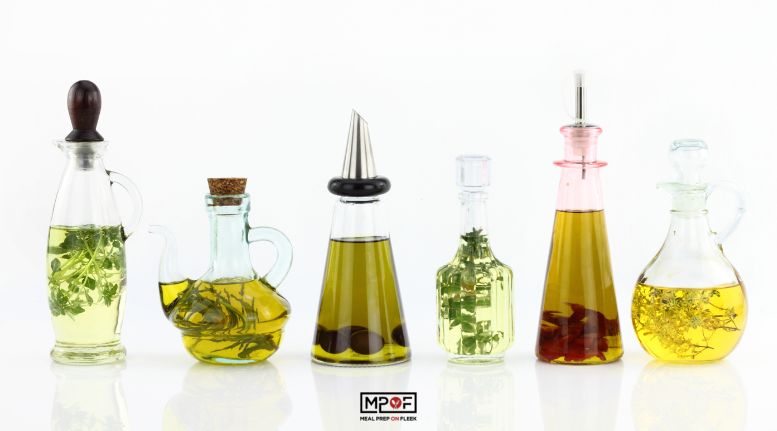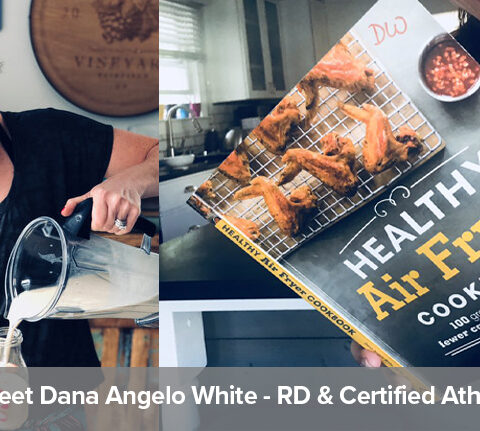There are so many different types of cooking oils these days. It can get confusing. Some people say you should use one type for salad, one type for sauteeing, and another for baking. Plus, some oils get a bad rap. What's a meal prepper to do?
Oil is often necessary in the cooking process to keep food from sticking to a pan, and boost flavor. In some cases, it can improve the health benefits of some foods (it's why we use dressing on greens, for example). But it can be so confusing trying to figure out what oil to use in which situation! It often depends on factors such as flavor profile, what type of cooking (grilling, searing, deep frying, etc.) and the type of heat needed. You might also be wondering about health benefits, cost, and how much you'll need. Some oils are better than others for cooking, and some others have been linked to health issues when used in higher temperature applications.
The Most Common Cooking Oils and How to Use Them
Avocado Oil
Avocado oil has excellent qualities for both cooking and using as is. It is high in oleic acid, monounsaturated fat, and vitamin E. This particular oil, while not cheap, helps lower bad cholesterol and lower blood pressure. Some people call it a carrier oil because it allows other flavors in your cooking to come forth, instead of the oil itself.
Standard avocado oil has a smoke point of around 520 F (271 C) which means it can withstand higher cooking temperatures without degrading; it is less likely to produce damaging free radicals in the body. The Takeaway: Avocado oil is a great oil for cooking most things, and for drizzling on salads or other dishes. (Drizzle it on top of this Steak and Avocado Salad!)
1 tablespoon = (Carbs: 0g - Protein: 0g - Fat: 14g)
Canola Oil
Canola is a type of cooking oil used in many countries around the world. It is a carrier oil, so it allows whatever is cooking in it to come forward. Canola oil has a decent amount of polyunsaturated fats and monounsaturated fats, and omega-3 and omega-6 fatty acids, which are good for the heart and cardiovascular health. It has a medium-to-high smoke point of around 400 F (204 C). However, health-conscious folks often stay away from canola because it's more likely to be genetically modified.
The takeaway: If you can, buy organic or non-GMO canola oil, or replace it with a healthier option.
1 tablespoon = (Carbs: 0g - Protein: 0g - Fat: 14g)
Rice Bran Oil
Rice Bran Oil is another great cooking oil. It's created by extracting the oil from the bran, or the outer layer of rice grain. That outer layer gives the oil its nutty flavor.
Use rice bran especially for frying and stir-frying; its high heat tolerance and high smoke point (approximately 490º F) can take it.
The takeaway: It's also an idea oil to use for salad dressings in you enjoy a slightly nutty flavor and is the preferred oil for Chipotle restaurants.
1 tablespoon = (Carbs: 0g - Protein: 0g - Fat: 14g)
Coconut Oil
Coconut oil offers a plethora of nutrients and health benefits. It is high in lauric acid, myristic acid, palmitic acid, monounsaturated fats, polyunsaturated fats, plant sterols, and medium-chain triglycerides. Some of the benefits associated with coconut oil includes weight management, improved hair and skin, and improved cognitive function. Sometimes it imparts a slight coconut taste or aroma in cooking.
Standard coconut oil has a smoke point of around 450 F (232 C). It's a good source of cooking oil for medium and high temperatures.
The takeaway: Use coconut oil for Asian and Indian dishes, where the flavor of coconut oil works well in those cuisines. Bring it out if you need to improve your fat macros or in vegan baking. Coconut oil is excellent for topical applications for moisturizing skin and hair.
1 tablespoon = (Carbs: 0g - Protein: 0g - Fat: 14g)
Grapeseed Oil
Grapeseed oil is a type of cooking oil known as a carrier oil. In contrast to its name, grapeseed oil does not taste like grapes or have a fruity taste at all. It is very high in omega-6 polyunsaturated fats, offers a good amount of monounsaturated fat, and a significant amount of vitamin E. This particular oil offers a cooking point of around 420 F (216 C). Grapeseed, then, is great for moderate cooking temperatures, and for drizzling on your favorite dishes.
The takeaway: Use this in baking and in general all-purpose cooking. It's often the preferred carrier oil of chefs.
1 tablespoon = (Carbs: 0g - Protein: 0g - Fat: 14g)
Olive Oil
Oh, olive oil. It is perhaps the most widely misunderstood oil of them all but can also be one of the healthiest, too. You've likely seen labels such as pure, light, extra virgin, virgin, refined, and so forth. Olive oil offers a range of flavor profiles from nutty to spicy. The taste depends upon multiple factors, including the types of olives used. Extra Virgin is often considered the healthiest among the olive oil varieties.
In general, real olive oil offers health benefits including improved heart health, reduced risk of cancer, reduced inflammation, reduced risk of stroke, balanced blood sugar, and prevention of diabetes. It also has the ability to reduce reducing bad cholesterol. Consider cooking with lighter variations of olive oil since they have a higher smoke point of around 470 F (243 C); extra virgin olive oil which has a smoke point of around 375 F (191 C). Some people swear by cooking with EVOO; in truth, most of our day to day cooking won't destroy what's in EVOO.
The takeaway: Extra Virgin olive oil is better for low simmers. It's also great as a finishing oil for salad, pasta, and bread. Be sure that the olive you purchase is 100% olive oil and not a blend of other oils. Look for the country of origin, date of production, a best-by date, and buy oils that come in dark glass bottles. (We like Cobram Estate and California Olive Ranch. Both of these company's oils are consistently praised for transparency of sourcing, authenticity, flavor, and performance.)
1 tablespoon = (Carbs: 0g - Protein: 0g - Fat: 14g)
Peanut Oil
Peanut oil is rich in the antioxidant vitamin E, and offers a fair amount of omega-6 fatty acids and phytosterols. It has also been linked with helping reduce bad cholesterol. Peanut oil offers the taste of peanuts; if you're allergic to them, steer clear of this type of cooking oil altogether.
The takeaway: Try this in Thai and Chinese dishes as it's perfect for sauteeing and frying thanks to its smoke point of around 450 F (232 C). Many restaurants fry in peanut oil.
1 tablespoon = (Carbs: 0g - Protein: 0g - Fat: 14g)
Sesame Oil
Derived from sesame seeds, this type of cooking oil is a great oil for medium heat with a smoke point of around 375 F (191 C) and it is full of antioxidants including vitamin E, lignans, phytosterols, sesamol, and sesaminol. Sesame oil has been linked with fighting inflammation, regulating blood sugar, benefiting hair growth, and lowering the risk of heart disease.
The takeaway: As its namesake indicates, sesame oil offers a sesame forward flavor profile, making it fantastic for Asian cuisine, eggs, and other dishes you’d like a slight sesame taste with.
1 tablespoon = (Carbs: 0g - Protein: 0g - Fat: 14g)
Vegetable Oil
Here's another one that be as confusing as it is widespread and inexpensive. Vegetable oil is extracted from various fruits, seeds, nuts, and grains and not veggies. Most grocery store vegetable oils are blends of oils such as canola, peanut, corn, olive, safflower, soybean, sunflower, etc.
The average smoke point for vegetable oil is around 400 F (204 C).
The takeaway: Overall, vegetable oil lacks consistent health benefits; use it sparingly. Try replacing your vegetable oil with other healthier options.
1 tablespoon = (Carbs: 0g - Protein: 0g - Fat: 13g)







